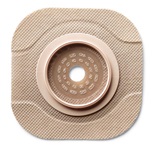WOC Nurse With an Ostomy Helps Patients Prevent and Solve Peristomal Skin Issues
Living with an ileostomy for more than 18 years, Wound, Ostomy and Continence (WOC) Nurse Aimee Frisch shares her experience and tips on how to be proactive with maintaining healthy skin around the stoma.

Read about Aimee’s decision to get an ileostomy and how her journey inspired her to give back to others.
By Aimee Frisch, BSN, RN, CWOCN
My family is no stranger to Inflammatory Bowel Disease (IBD). My father passed away from complications of Crohn’s disease at age 57. My grandmother had ulcerative colitis and I have several cousins with Crohn's. At age 26, just when I thought I had avoided the family curse, I began to have symptoms associated with IBD and was ultimately diagnosed with Indeterminate Crohn’s/Colitis. This meant that I had symptoms and disease progression of both Crohn’s disease and ulcerative colitis.
Making a Difficult Choice
Given my mixed family history, it was very difficult to determine which disease was causing the symptoms. In only eight months, I went from being active and healthy to being hospitalized and close to dying. My medical team eventually gave me the option of getting an ileostomy, as I was getting worse as each day passed.
At the time, I was just starting my life – planning for my upcoming wedding and studying to be a bilingual elementary school teacher. And up to that point, I had only negative experiences with ostomies. Much to the surprise of my medical team and family, I said that I had to think about my options, even though not choosing surgery would mean death.
Deciding to Live and Fight
I’m very grateful that I ended up making the decision to get the ileostomy – and to live and fight. I had several complications and multiple surgeries, however, I was able to make it to my wedding day. I even became pregnant eventually, and am now mom to my miracle daughter who recently turned 10!
Along the way, I met several people living very productive and joyful lives with an ostomy. I also met an ostomy nurse who changed the course of my life. She was the most dedicated, kind person I had ever known. She was relentless in helping me overcome complications and finding solutions that would allow me to make it to my wedding day without worrying about my pouch.
Giving Back to Others With Ostomies
It was during that time that I decided that I wanted to share my experiences and give back. I wanted to be that source of knowledge for others living with an ostomy that my nurse was for me. In 2007, I decided to completely change my career and become a Wound, Ostomy, and Continence (WOC) nurse. I was accepted into a rigorous, accelerated nursing bachelor’s degree program. I then worked for two years as a nurse before being accepted into the Cleveland Clinic WOC nursing program. I celebrated my tenth year as a Certified WOC nurse in 2020, and I am so happy that I chose that path. It has been the most rewarding experience.
As a WOC nurse with an ostomy, I feel I have a unique perspective to share when working with people with ostomies. I am able to empathize with the struggles and successes of those in my care, since I have learned to manage and overcome my own challenges. I strive to be a credible source of knowledge, and to teach my new patients to be proactive vs. reactive in managing their ostomies and life with an ostomy in general. When appropriate, I share some of the issues that I and other people with ostomies have experienced, and provide helpful tips.
Preventing and Managing Peristomal Skin Itchiness and Irritation
One of the issues that I have had to deal with is skin itching and irritation. For a long time, I thought that it was normal for the skin under my pouching system to be itchy or red, given that it is covered 24 hours/day. I figured that this was something I just had to live with. There were times, however, that it was very difficult. Sometimes I itched so badly that it would interrupt what I was doing and I couldn’t focus on anything else. It was especially noticeable when I was due to change my wafer and several hours after changing it.
As a clinician, I saw patients struggling with the same issue. Some, like me, did not have noticeably red skin but were still experiencing intense itching. When I researched solutions to this problem, most focused on what to do after the irritation and/or itching became a nuisance. I realized that I needed to change my mindset from being reactive to proactive – both in my personal experience and in my professional practice.
After years of trying different techniques and products -- myself and with patients – I made the list below to help people know what is normal/abnormal and be proactive in solving skin issues. I also encourage people with ostomies to try different pouching systems until they find one that keeps the skin under the wafer looking as healthy as the rest of their skin.
What’s normal: The skin under your wafer should look and feel just like the skin anywhere else on your abdomen.
- It should be smooth, not raw or dry
- It should be the same color as the rest of your skin
How to keep your peristomal skin healthy:
- Consider using only warm water to cleanse your skin. Many soaps and cleansers contain ingredients that can leave behind a film. This film may irritate the skin or disrupt your skin barrier’s ability to adhere, which can lead to leaking.
- Make sure your skin is dry before replacing your wafer
- Change your pouching system regularly. I used to push the limits and wait until it was almost too late before I changed my wafer, which would irritate my skin. It’s best to change more frequently when possible (i.e., every 4 to 5 days). If you are active or live in a warmer climate, you may want to consider changing more frequently.
- Use gentle products like water-based adhesive removers to remove your wafer
- Utilize ostomy accessories to help get a good skin barrier fit. This will help you avoid leakage, which can make your skin more susceptible to itching and irritation.
- Use ostomy products that are infused with ceramide, a natural component of human skin that can help keep your skin healthy
- Don’t try to “live” with the itching, as this is a sign of something abnormal. Meet with your ostomy nurse to determine the cause.
I hope to continue to share these tips with many more people living with an ostomy. I’ve met so many amazing people along the way who have reminded me that an ostomy does not define you. And it can’t stop you from living life and following your dreams.
Aimee Frisch was diagnosed with indeterminate Crohn’s Colitis in 2002 and has had many surgeries. First for a temporary stoma, then in 2004, she received a permanent stoma. In 2008 Aimee went back to school to become a WOC Nurse. She was certified in 2010 and since then has worked at Froedtert Menomonee Falls Hospital in Menomonee Falls, Wisconsin.
Financial Disclosure: Aimee Frisch received compensation from Hollister Incorporated for her contribution to this article.
- 5 Shares
- 36 Recommended





 Call Us
Call Us  Email Us
Email Us  Join Us!
Join Us!  Sign Up
Sign Up 